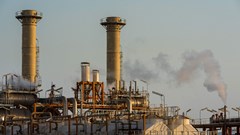Alaska LNG project aims to transform US energy exports to Asia
Japan's top power generator JERA, the world's second-largest LNG buyer after China, may consider the $44 billion Alaska LNG project as a potential source of liquefied natural gas (LNG) supply, Reuters reported. JERA, which sources about 10% of its LNG from the US, purchases around 35 million metric tonnes of LNG annually and is exploring options to diversify its portfolio for greater supply stability.
The massive infrastructure project would deliver natural gas from Alaska's North Slope fields via an 800-mile pipeline for both domestic use and export to Asian markets. By bypassing the Panama Canal, it would potentially transform energy trade routes between North America and Asia. The project involves constructing a pipeline from fields north of the Arctic Circle to southern Alaska, where the gas would be cooled into liquid form and shipped on tankers.
In March 2025, Taiwan's CPC Corp has signed a preliminary agreement with Alaska Gasline Development Corp, marking a significant step forward for the Alaska LNG project as officials from Japan, South Korea and Thailand prepare to evaluate potential involvement. This renewed international interest could accelerate one of America's most ambitious energy infrastructure initiatives, designed to substantially increase US natural gas exports to Asia.
Progress has been made with Taiwan's state energy company CPC Corp, which recently signed a non-binding agreement with the state-run Alaska Gasline Development Corp to purchase LNG and invest in the project, Reuters reported. Taiwan's President Lai Ching-te indicated this move would ensure the island's energy security.
For Asian countries, shipping LNG from Alaska would offer cost and time advantages compared to traditional sources in Australia, the Middle East and the US Gulf Coast. However, potential buyers have historically expressed caution about the project's substantial costs and viability.
The US Department of Energy has highlighted multiple benefits of the Alaska LNG project, including job creation, enhanced energy security for the United States and allies, and an estimated $10 billion annual reduction in the US trade deficit.
South Korea's Industry Minister Ahn Duk-geun has indicated that while discussions are ongoing, "there are still a lot of things that need to be done" through due diligence to "understand the local situation more accurately." South Korea is dispatching an inspection team to evaluate the project further.
Despite being discussed for years, the Alaska LNG project faces challenges related to its scale, cost and complexity. If successful, the project is not expected to begin shipping liquefied gas until the early 2030s, representing a long-term investment in America's energy export capabilities.
KEEPING THE ENERGY INDUSTRY CONNECTED
Subscribe to our newsletter and get the best of Energy Connects directly to your inbox each week.
By subscribing, you agree to the processing of your personal data by dmg events as described in the Privacy Policy.
More gas & LNG news

BP’s Turnaround Plan Tested by Weak Earnings, Falling Shares

Woodside gives green light to massive Louisiana LNG project

China Re-Exports Record Monthly Volume of LNG on Weak Demand

US Eyes Post-War Joint Business With Russia in Energy, Metals

Hedge Funds Seek Out Ways to Navigate Trump’s Anti-Climate Agenda

China May Exempt Some US Goods From Tariffs as Costs Rise

Spain Wants EU to Keep Methane Goals in Search for LNG Supplies

Booming Power Demand Means Longer Wait for GE Vernova Customers

US Widens Sanctions on Iran to Target Lucrative Gas Exports
















